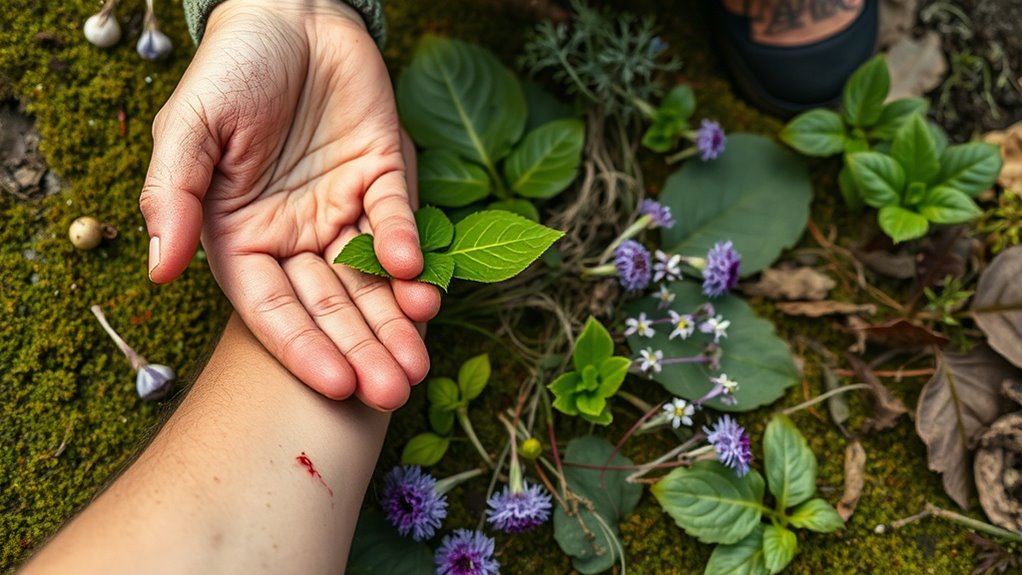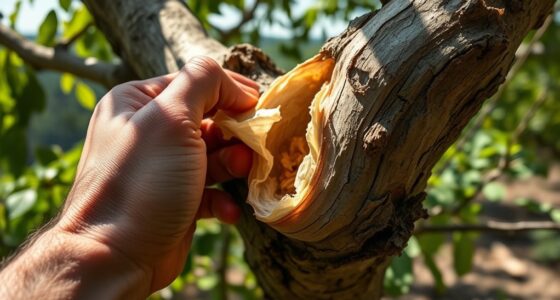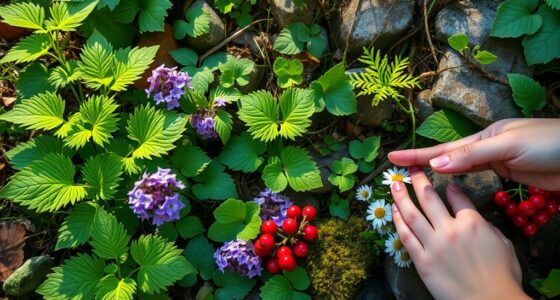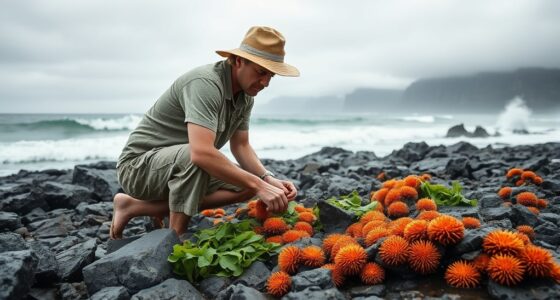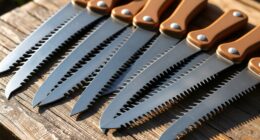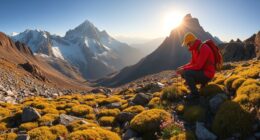To use foraged plants in first aid, first identify safe, common herbs like plantain, yarrow, and calendula. Harvest them carefully from clean areas and prepare them through infusions, poultices, or salves. Apply plantain to insect bites or burns, use yarrow to stop bleeding, or apply calendula for cuts. With proper harvesting and preparation, you can efficiently treat minor injuries and skin conditions — and more useful tips await those ready to explore further.
Key Takeaways
- Identify and harvest medicinal plants like plantain, yarrow, and calendula safely from clean environments during peak potency times.
- Prepare herbal remedies such as infusions, poultices, and tinctures to treat wounds, burns, insect bites, and inflammation.
- Use plantain leaves and yarrow to stop bleeding, soothe skin irritations, and promote healing of cuts and bruises.
- Utilize plants like aloe vera and California poppy for rapid burn relief and pain management in emergency situations.
- Understand the historical and cultural significance of herbal remedies to enhance traditional first aid practices.
Discovering Common Medicinal Plants for Emergencies

When emergencies arise in the wild or during outdoor activities, knowing how to identify and use common medicinal plants can make a crucial difference. You should familiarize yourself with plants like arnica, which relieves muscle pain and bruising when applied topically or taken as a homeopathic remedy.
Calendula is another key plant, offering antiviral and anti-inflammatory benefits for cuts, burns, and rashes.
California poppy acts as a mild sedative and pain reliever, useful for managing discomfort.
Tea tree oil provides broad-spectrum antimicrobial effects, helping treat infections and skin conditions.
Common plantain, often dismissed as a weed, soothes skin, promotes wound healing, and eases stings or bites.
Recognizing these plants allows you to respond effectively when professional help isn’t immediately available.
Locating and Harvesting Key Foraged Plants
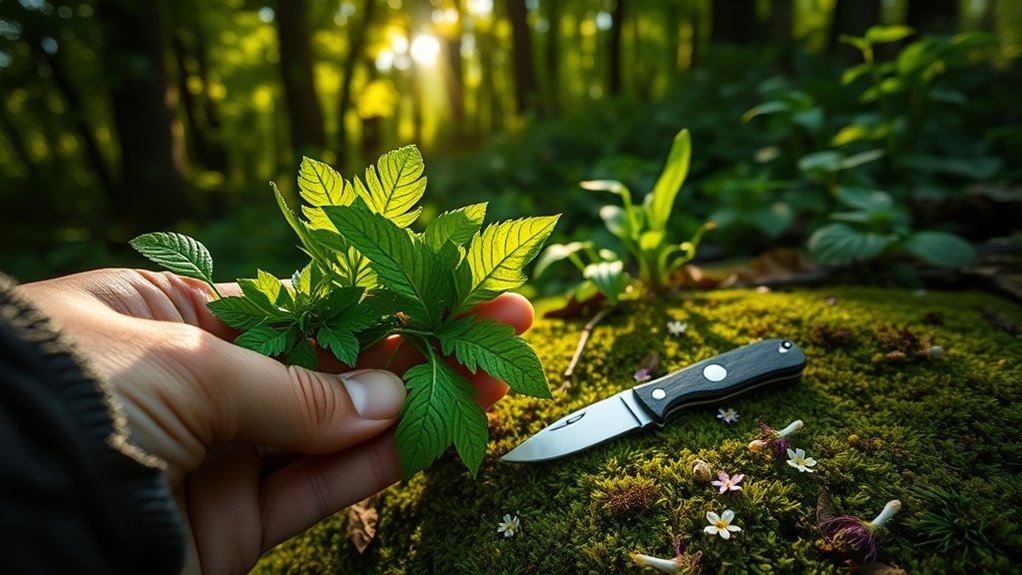
Locating and harvesting key foraged plants requires careful observation and knowledge of their preferred habitats. For example, dandelions grow in lawns and along roadsides, making them easy to spot. Burdock prefers woods, riverbanks, and roadside areas, while wild violets thrive in shady spots and forest edges. Wild geraniums are found in wooded areas, and plantain often grows in cracks in pavements and disturbed sites. To harvest safely, identify plants accurately using guides or expert advice to avoid toxic lookalikes. Only gather from clean, unpolluted environments and harvest sustainably—pinching leaves or roots rather than uprooting entire plants. Timing matters too; pick plants when their medicinal properties are at their peak, usually during specific seasons or times of day. Understanding plant identification is crucial for safe foraging and ensuring you are collecting the right species. Additionally, being aware of local regulations and foraging guidelines can help prevent environmental damage and legal issues. Proper knowledge of air quality and pollution levels can also influence where and when you forage, ensuring the plants you collect are safe and potent. Being mindful of pollution levels can help protect your health and the environment while foraging.
Simple Preparation Techniques for Herbal First Aid
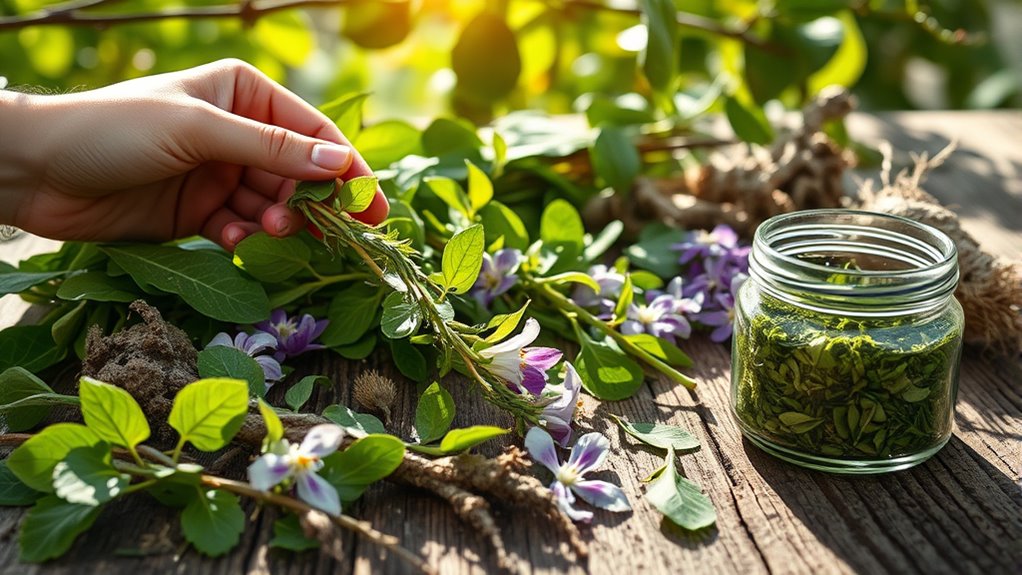
Once you’ve identified and harvested the right plants, preparing herbal remedies for first aid becomes straightforward. For infusions, steep leaves, flowers, or stems in hot water for 10-15 minutes, then strain. Use fresh infusions immediately for maximum potency. Anime movies offer a diverse range of stories that can inspire and comfort during healing moments. To make poultices, crush fresh herbs or rehydrate dried ones with water, then apply warm or cold directly to wounds or insect bites, wrapping with clean cloth. Change the poultice every few hours. Tinctures involve soaking herbs in alcohol or vinegar for several weeks, then straining; dilute tinctures in water for wound cleansing or apply directly. For salves, infuse dried herbs in carrier oils for weeks, then mix with beeswax and store in airtight containers. Herbal washes and sprays are diluted infusions or tinctures in sterile water, ideal for gentle cleaning. Color accuracy in the herbs can influence the effectiveness of certain remedies, making proper preparation essential. Additionally, understanding Vetted – Mother Baby Kids guidelines can help ensure the safety and efficacy of your herbal first aid preparations. Proper herbal extraction techniques are crucial to maximize the medicinal properties of the plants used. Incorporating knowledge of pregnancy safety is also important when preparing herbal remedies to prevent unintended effects.
Practical Uses of Foraged Plants in First Aid Situations
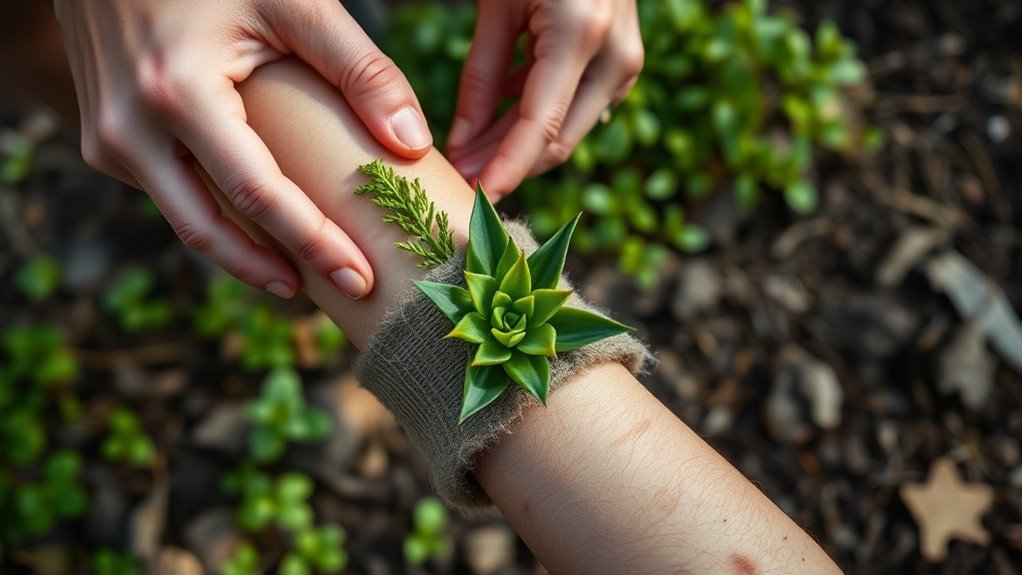
Foraged plants offer versatile solutions for first aid situations, especially when immediate medical supplies are unavailable. Plantain leaves are excellent for soothing insect bites, rashes, blisters, burns, and cuts thanks to their anti-inflammatory and antiseptic properties.
Yarrow is invaluable for stopping bleeding and promoting clotting in minor injuries, while onion skins can help close wounds. Rose petals can be used to butterfly cuts, similar to onion skins. Cayenne pepper may help halt bleeding but can sting.
For inflammation and skin irritations, heated plantain leaves, yarrow, and thyme essential oil are effective. Aloe Vera provides rapid relief for burns, and Echinacea supports immune healing.
These foraged plants serve as practical, natural first aid tools, especially when conventional supplies are out of reach.
Historical Significance and Traditional Uses of Medicinal Herbs

Throughout history, medicinal herbs have played an essential role in healing practices across cultures, shaping both traditional and modern medicine. Ancient civilizations like Sumeria used over 250 plants in their remedies, documented on a clay slab 5,000 years ago.
Chinese medicine, recorded in “Pen T’Sao,” listed 365 plants around 2500 BC, many still in use today. Indian Vedas mention treatments with native plants, while Egyptian texts like the Ebers Papyrus detail herbal cures for various ailments.
Dioscorides’ writings introduced Asian herbs to Europe, expanding herbal knowledge during the Middle Ages. Indigenous cultures, such as Native Americans and Africans, contributed unique herbal traditions.
These ancient texts often combined herbal remedies with magical formulas, reflecting the deep cultural significance of plants in healing practices across history.
Incorporating Foraged Plants Into Your First Aid Kit
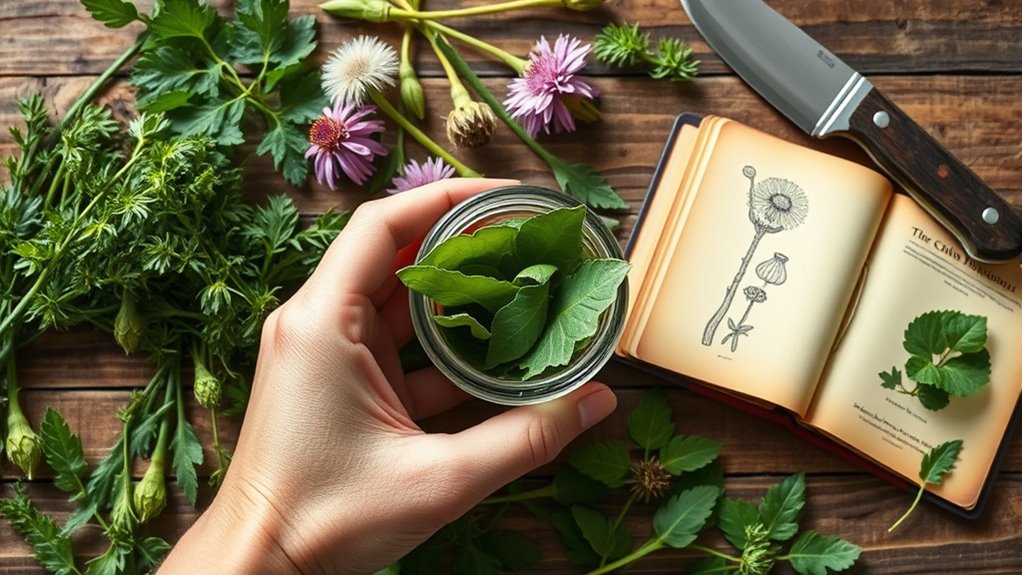
Incorporating foraged plants into your first aid kit can provide natural, readily available remedies for common injuries. Start by collecting plants like plantain and yarrow, which can be crushed and applied directly to wounds to reduce inflammation and stop bleeding. Global chaos highlights the importance of having reliable, natural alternatives in emergency situations. Comfrey roots can be mashed into poultices for bruises or sprains, while calendula flowers, infused in oil, make soothing salves for skin irritation or burns. Always verify correct identification to avoid toxic look-alikes. Being aware of local plant knowledge can enhance the safety and effectiveness of your herbal remedies. Developing a basic understanding of herbal safety is essential to prevent adverse reactions and ensure proper use. Proper handling and preparation techniques are vital to maintaining the potency of herbal remedies and avoiding contamination. Use gloves and maintain hygiene when handling herbs to prevent infections. Incorporating dried herbs or prepared salves can also be beneficial to extend their shelf life and ensure availability during emergencies. Educate yourself on proper preparation and safe usage to maximize their benefits. Combining herbal remedies with conventional supplies creates a versatile, sustainable first aid kit for emergencies.
Frequently Asked Questions
How Can I Identify Medicinal Plants Safely in the Wild?
To identify medicinal plants safely in the wild, you need to use multiple resources like regional field guides, online tools, and expert advice.
Observe plants carefully across seasons, noting characteristics like leaves, flowers, and growth habits.
Be aware of lookalikes and poisonous species.
Always verify your identification by comparing sources and consulting local experts, ensuring you’re confident before harvesting or using any plant for medicinal purposes.
Are There Any Plants I Should Avoid Harvesting for Safety Reasons?
You should avoid harvesting plants known for their toxicity or allergenic properties. Stay away from wolfsbane, poison ivy, poison oak, giant hogweed, and deadly mushrooms like death cap.
Also, skip plants with toxic berries, such as American pokeweed and doll’s eyes. Always be cautious around invasive or polluted plants, and never consume anything that you can’t positively identify as safe.
When in doubt, it’s better to leave it.
What Are the Best Storage Methods for Dried Herbal First Aid Supplies?
To store dried herbal supplies effectively, choose airtight containers like glass jars or vacuum-sealed bags to keep them fresh.
Keep them in dark, cool places such as cabinets or basements to prevent light and heat damage.
Label everything with dates to monitor freshness, and regularly check for signs of moisture or spoilage.
Avoid exposure to sunlight, heat, and humidity to prolong their shelf life and maintain potency.
Can Foraged Plants Replace Conventional First Aid Treatments Completely?
You might think foraged plants can be a magic wand for all injuries, but they can’t replace conventional first aid entirely. While some plants offer healing benefits, they lack standardization, and misidentification risks can be deadly.
For serious wounds or emergencies, always rely on proven treatments.
Foraged plants are valuable allies in remote or resource-limited situations, but they should complement, not substitute, professional medical care.
How Do I Ensure Proper Dosage When Using Foraged Herbs Medicinally?
You guarantee proper dosage by following established guidelines based on herb type and your needs. Start with small amounts, especially if you’re new, and observe how your body reacts.
Adjust the dose gradually, keeping in mind special populations like children or pregnant women. Always measure herbs carefully, and when in doubt, consult a professional herbalist to prevent adverse effects and ensure safe, effective use.
Conclusion
By learning to identify and prepare local medicinal plants, you turn a wild patch into your own natural first aid kit. With a little knowledge, you’re not just patching up cuts—you’re empowering yourself to handle emergencies confidently. Remember, knowledge is power, and the more you learn about foraged plants, the better equipped you’ll be when it counts most. So, stay curious, keep exploring, and let nature be your first line of defense.

